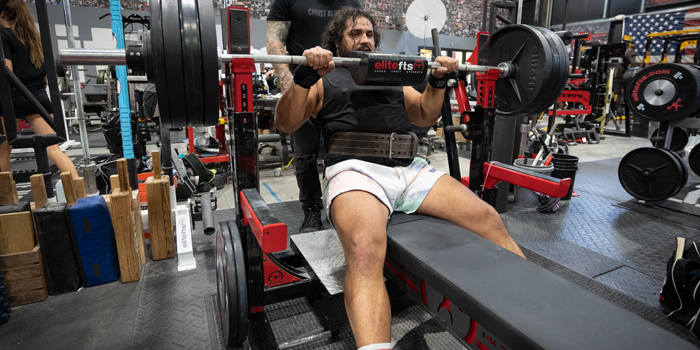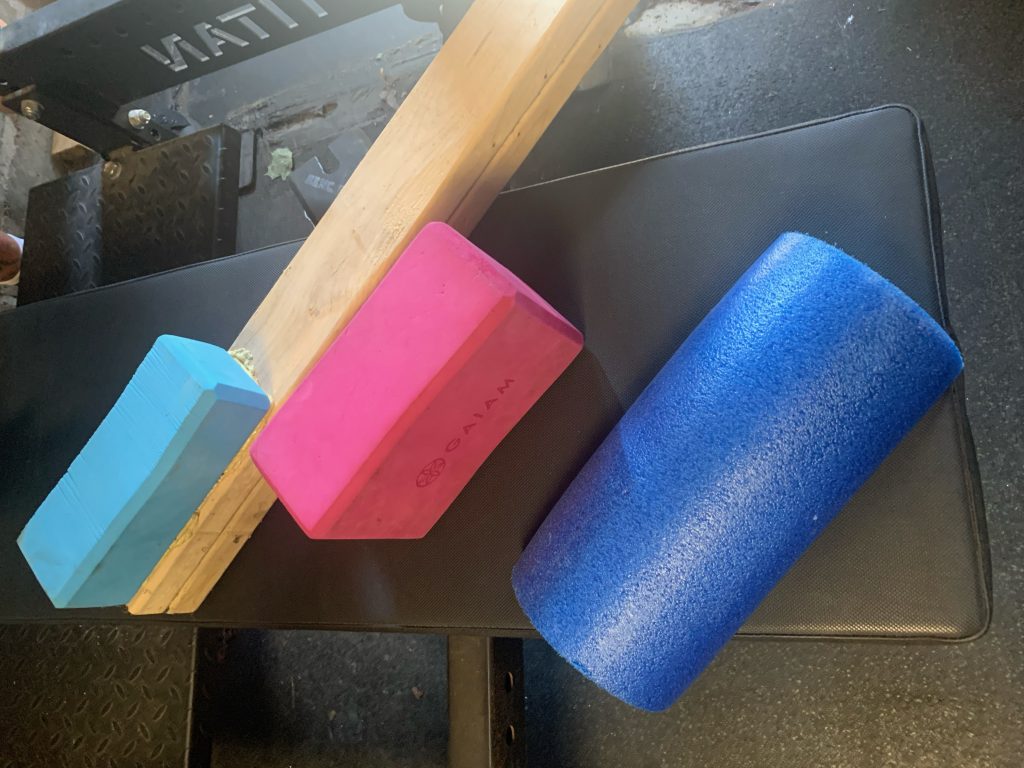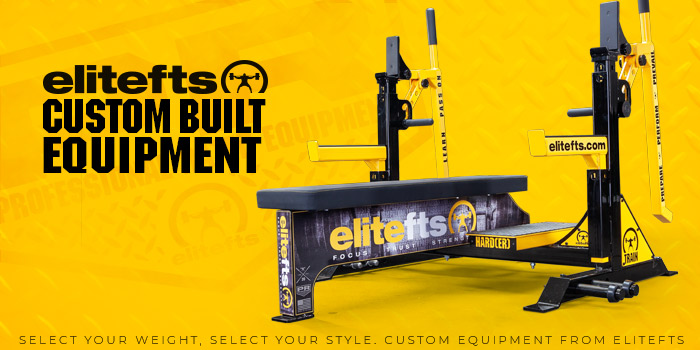
Foam training is nothing new, and I don’t claim to have any revolutionary ideas. I want to pass along some knowledge and ideas I’ve come across throughout my training and coaching. These tried-and-true training modalities are probably a missing piece to your training. It’s important to pass on what we have learned from people that are better and smarter than ourselves. Once I was handed these tools, I started off running with them! You may want to try using foam if you:
- Have painful elbows or shoulders and looking for a cheap and easy way to do a variation by yourself.
- Are looking for extra pressing volume that won’t leave you overly sore and is easier to recover from.
- Want to train “off the chest” strength as well as lockout strength.
I found it hard trying to obtain the conventional foam most athletes use in training. You know, the couch cushion foam? Online sellers have this, but it can be pricey. Fear not! I have found some inexpensive alternatives that are beneficial for everyone.
Foam Roller
The first alternative is a foam roller, or better yet, a 12-inch half roller. The half roller will fit and stick underneath your shirt and is the equivalent of a one-and-a-half board. When you let it sink into the foam, it turns into just a half board.
Yoga Block
The second foam variation is a yoga block. Finally, a use for these weird color yogi blocks! I just stole my fiancé’s yoga block from her yoga kit. Same deal here folks, place it under your shirt, and you’re good to go. One difference from the half roller is that it's bigger and denser. Second, it’s as thick as a 3-board, but when you let the weight of the bar sink in, it drops to about a half board. The third difference is that the yoga block tricks you into thinking it’s your ally when in all reality, it is a backstabbing S.O.B. You’ll feel a slight spring-like effect when pressing out of the foam, but when you’re out of the foam, it feels like you hit a brick wall. It’s a great way to teach you not to lose speed (or tightness) while getting comfortable punching it to the fucking ceiling!
RECENT: The Most Important Facets of Team Training
Yoga Block + 2x4
The third alternative is the yoga block again, except this time we're slapping that bad boy on a 2x4 or a couple. It’s like any other board press, but you force a little extra lockout strength with less strain on the shoulders and elbows. elitefts sells a manpon pressboard. If you have the loot, BUY it! This alternative, although convenient, is at its best ghetto step-cousin.
Here are more benefits of using foam:
- If you're like most of us and have been in this game for any substantial amount of time, then you may get annoying aches and pains in your shoulders and elbows. Now, this isn’t the end-all be-all of pain-free pressing movements—think of it is another tool in your fight against gravity with less pain. The costs are about a total of $8-12 per piece and doesn’t require a team for you to use it. Throw them in the gym and then tuck it under your shirt and boom goes the dynamite!
- If you’re someone who is looking for some extra pressing volume in your program with a low training economy, this may be part of your answer. Let me elaborate. What I mean is, this is a shortened ROM and when you use this foam correctly, it breaks up the kinetic chain (the eccentric and concentric portion of the lift). Much like a properly executed box squat, it becomes more recoverable.
- When using the foam correctly, I believe it will work on your lockout strength and build strength off the chest as well. You use the foam by actively rowing the barbell through the foam, pausing momentarily, then pressing as hard and explosively as possible while maintaining tightness. The foam absorbs the barbell's kinetic energy which is dispersed throughout the foam during the momentary pause (isometric which helps to work 5 to 15 degrees in both directions of the pause.) This leaves you forced to regenerate the reversal strength to get the bar out of the foam and press fully to lockout. The best comparison I can make to it is the difference between jumping out of sand vs. jumping off concrete. Obviously, there is going to be a shortened ROM, so you may be a tad stronger than straight off the chest. For some, this is easier and for others it’s harder (ME). If you slap a yoga block on a 3-board and expect it to work off your chest, apply common sense and reap the rewards.

Example Training Sessions Using Foam
ME Upper: Example 1
- 12-inch foam roller close grip press 1RM
- 12-inch foam roller 3x5 @ 65% with 5-sec negative
- 2-arm row 4x12
- Dumbell tri ext superset w/ cable push downs 4x8 and 4x25
- Dumbell shrugs 3-4x20
ME Upper: Example 2
- 1-board foam yoga block 1RM
- 1-board foam yoga block 3x5 @ 65% with 5-sec pause
- Barbell bent-over row 4x8
- Diamond push-ups 3x fail
- Dumbell rear delt fly 4x12
- Band pull aparts 4x30
DE Upper: Example 1
- Foam yoga block 9 x 3 @ 50% + red mini band 3 different grip
- Weighted dips 3 x 15
- 1-arm row 4 x 12
- Lat pulldowns 4 x 12
- Banded tricep ladder 3 x 20 each band
- Dumbell seated upper back cleans 3 x 15
DE Upper: Example 2
- 12-inch foam roller 5x5 @ 75% close and medium grip
- Pull-ups 4x fail
- Meadows row 4x15
- Rolling tri ext 4x8
- Face pulls 4x30
Conclusion
I’m not promising that this will solve all your bench-pressing problems, but this may be a major piece to solving any issues you’re having. Again, make sure to apply common sense and use it where necessary. I've provided a few basic examples, but don’t let it stop you there! Foam training can be used as assistance work for sets and reps and can be rotated weekly as you see fit.
I credit my training partner Chris Neeves who implemented these foam alternatives in his training out of necessity. He trained alone for years and had to circumvent injuries on his own without any excuses. He expanded the test pool by bringing this into our club. Our club members have seen the benefits of using foam. Chris is a 500-pound-plus raw bench presser (built, not born), and our results have been speaking for themselves. Hopefully, this helps one more athlete lay another brick into earning that elite total, personal record, or number one spot at their next meet. Remember, “Iron sharpens iron.”
Chad Faria is a competitive powerlifter (raw with wraps) from New Bedford, Massachusetts. He owns Bristol County Barbell club—a one-car garage and a 450-square-foot carport. Chad is a Westside Special Strengths Coach, RPR Level 1 Practitioner, PN1 Coach, and ISSA Master Certified Personal Trainer. Aside from his son, fiancé, and livelihood, his barbell club is one of the biggest priorities in his life. Chad's goal is to help whoever is serious about becoming the most dangerous and strongest version of themselves.











Foam is the way to go for board work.